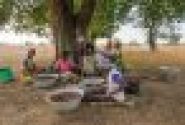
Some of the requirements of agriculture – depending on the types of crops – may conflict with long-term environmental benefits. Neil Palmer (CIAT).
PUNTA DEL ESTE, Uruguay (22 November 2012)_Researchers are using an innovative new approach to study the Earth’s landscapes and natural resources to try to figure out how to feed the world, reduce poverty and protect the environment – all at the same time.
Governments, policy makers and scientists worldwide have been experimenting for years with different landscape approaches – from watershed management and biological corridors to habitat restoration – but these efforts have focused primarily on the short-term, local-scale.
The idea behind “landscape management science” is to zoom outward, examining environmental and economic problems on larger spatial scales. In this way, researchers can try to figure out how to manage, conserve or restore valued natural resources, especially those that provide important economic goods and services.
The new approach could help negotiators heading to the United Nations climate change summit in Doha, in December, to understand how better to manage the world’s resources faced with the threat of a changing climate.
A big part of the landscape process is determining what trade-offs we can live with, said Robert Nasi, Director at the CGIAR Research Programme on Forests, Trees and Agroforestry, at Second Global Conference on Agricultural Research for Development (GCARD2), which took place in Uruguay late last month.
It was attended by researchers from both the agricultural and forestry fields.
For instance, some of the requirements of agriculture – depending on the types of crops – may conflict with long-term environmental benefits, resulting in the clearing of forests, threat to water supplies, and loss of biodiversity.
“We have a wicked problem,” Nasi said. “We have to feed the world, reduce poverty and protect the environment, all at the same time.”
“The question becomes, ‘what are you prepared to give up?’ Some of the things in the landscape are irreplaceable, people cannot use something else.”
The task will not be an easy one.
The first step is simply getting the scientific community to consider farms, livestock, patches of trees and shrubbery, forests, rivers, and roads linking villages as part of a larger mosaic, said Ravi Prabhu, from the World Agroforestry Center.
This is crucial, he said, “because this is how people actually live. They don’t live under a tree — they live in an integrated landscape.”
Then, he said, we need to look at what resources are available.
With a global population moving toward the 9 billion people mark, one of the most central questions will continue to be how to feed them all, others at the conference noted.
Producing more food will not solve the problem of malnutrition, said Rachel Kyte, Vice President of Sustainable Development at the World Bank.
“If we have limited resources and we wish to…ensure nutrition security… where would we put those resources?” she asked.
“Do we put some in agricultural research, do we put some into extension services, do we put some into other forms of research?” she asked, stressing that this agenda needs to work across sectors, including not just research for agriculture but also the agricultural sector as well as broader environmental research.
Nasi agrees, saying we should start by doing a better job managing what we already have. In other words: Find ways to be less wasteful.
Then we must also look at and analyse the complex makeup of the landscapes –and how humans interact with them.
Trees, for instance, have value beyond forests. They are important in many other systems, including agricultural landscapes or grasslands. With the huge ecological diversity globally, together with the cultural and socioeconomic diversity of people who are dependent on forests and agroforestry, it follows that the solution will only come through complex management and a diversity of research strategies.
Landscape management science requires the use of complicated methodologies and it will take time to determine the impacts of the research, said Jeffrey Sayer, member of the Independent Science and Partnership Council of the CGIAR.
“This research is very new and innovative,” he said. “We need some demonstration on how these large scale landscape initiatives can actually work… we need networks of practitioners, documents on best practices.”
To start the process, CIFOR recently submitted a set of 10 guiding principles to ‘landscape level approaches to sustainability’ that were recognised by the United Nations Convention on Biological Diversity (CBD) in Hyderabad last month.
The principles stress the needs to strengthen connections and better integrate research in the agricultural, forestry, energy, and fishery sectors.
Landscapes provide scientists with a very real situation that “we can’t achieve impacts without partnerships,” said Sayer.
Landscape research forms part of the CGIAR Research Program on Forests, Trees and Agroforestry, where four of the world’s leading research centres —the World Agroforestry Centre, CIFOR, CIAT and Bioversity— work together to enhance the management and use of forests, agroforestry and tree genetic resources.
We want you to share Forests News content, which is licensed under Creative Commons Attribution-NonCommercial-ShareAlike 4.0 International (CC BY-NC-SA 4.0). This means you are free to redistribute our material for non-commercial purposes. All we ask is that you give Forests News appropriate credit and link to the original Forests News content, indicate if changes were made, and distribute your contributions under the same Creative Commons license. You must notify Forests News if you repost, reprint or reuse our materials by contacting forestsnews@cifor-icraf.org.
Further reading
The restoration of forest biodiversity and ecological values
Agricultural expansion: an “either or more” factor in deforestation
Forests, food and livelihoods: What policymakers should know
"Landscape approaches” can end the debate that pits agriculture against forests, say experts
Landscape rehabilitation of degraded tropical forest ecosystems
U.N. recognises new guidelines to better manage competing demands for land











